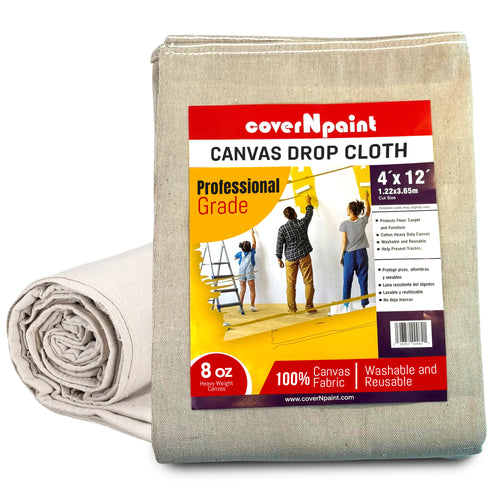When it comes to protecting surfaces during painting or renovation projects, the debate often centers around the best type of protective covering. Many professionals and DIY enthusiasts prefer canvas drop cloths because of their durability and versatility.
Understanding the Material Composition
These protective cloths are typically made from tightly woven cotton fabric. This material is chosen for its durability, absorbency, and resistance to tearing. The tight weave of the fabric prevents paint and other liquids from seeping through, providing an effective barrier between the working area and the surfaces being protected.

Construction and Quality
The quality of the cloth can vary based on factors such as thread count and weight. Higher thread counts result in a denser fabric, which offers better protection and durability. Heavier cloths, often measured in ounces per square yard, are more robust and can endure more wear and tear. Investing in high-quality cloths can significantly extend their usable life.
Factors Affecting Reusability
Several factors can influence how many times you can reuse these protective cloths. Understanding these factors can help you make informed decisions about when to replace or continue using them.
Type of Project
The nature of the project you're working on plays a crucial role in determining the cloth's lifespan. For example, projects involving heavy-duty painting, staining, or varnishing may cause more wear and tear on the cloth compared to lighter tasks like dusting or minor touch-ups.
Frequency of Use
How often you use the cloths will also impact their longevity. Frequent use will naturally lead to quicker deterioration. If you use them daily, you might need to replace them more often than if you use them only occasionally.

Cleaning and Maintenance
Proper cleaning and maintenance are vital for extending the life of your protective cloths. Failure to clean them properly after each use can lead to the buildup of paint, solvents, and other materials, which can cause the fabric to degrade more quickly.
Storage Conditions
Storing the cloths in a dry, cool place away from direct sunlight and harsh chemicals can prevent premature aging and damage. Improper storage can lead to mold growth, fabric weakening, and other issues that reduce their lifespan.
Proper Maintenance Practices
To maximize the reusability of your protective cloths, it's essential to follow proper maintenance practices. Here are some tips to help you care for your cloths and ensure they remain effective for multiple uses.
Cleaning After Each Use
After each use, shake out the cloth to remove any loose debris. If the cloth is heavily soiled with paint or other substances, rinse it thoroughly with water before washing. Use mild detergent and cold water to wash the cloth, and avoid using bleach or fabric softeners, as they can damage the fibers.
Drying
Air drying is the best method for drying these cloths. High heat from a dryer can cause the fabric to shrink and weaken over time. Hang the cloths in a well-ventilated area to allow them to dry completely before storing.
Inspecting for Damage
Regularly inspect your cloths for signs of wear and tear. Look for holes, frayed edges, and thinning fabric. If you notice any significant damage, it may be time to retire the cloth and replace it with a new one.
Storing Properly
Fold the cloths neatly and store them in a dry, cool place. Avoid stacking them under heavy objects or exposing them to direct sunlight, as these conditions can cause the fabric to deteriorate faster.
Tips for Maximizing Use
To get the most out of your protective cloths, consider these additional tips and tricks.
Rotate Cloths
If you have multiple cloths, rotate their use to distribute wear and tear evenly. This practice can help extend the overall lifespan of your cloth collection.
Use Appropriate Sizes
Choose the right size of cloth for your project. Using a larger cloth than necessary can lead to excessive folding and bunching, which can cause uneven wear. Conversely, using a cloth that's too small may not provide adequate protection and can result in more frequent replacements.
Avoid Harsh Chemicals
Harsh chemicals and solvents can weaken the fabric and reduce its lifespan. Whenever possible, use milder cleaning agents and avoid direct contact with strong chemicals.
Repair Minor Damage
For minor tears or holes, consider repairing the cloth rather than replacing it. Simple sewing techniques can extend the usability of the cloth, allowing you to get more mileage out of it before needing a replacement.
Environmental Considerations
Reusing protective cloths not only saves money but also has environmental benefits. By extending the life of these cloths, you reduce waste and decrease the demand for new materials. This practice aligns with sustainable and eco-friendly approaches to home improvement and professional projects.
Reducing Waste
By reusing cloths, you minimize the amount of waste generated from your projects. Instead of discarding a cloth after a single use, you can repurpose it multiple times, reducing the environmental impact associated with manufacturing and disposal.
Sustainable Practices
Opting for reusable cloths over disposable alternatives supports sustainable practices. Cotton, being a renewable resource, has a lower environmental footprint compared to synthetic materials. Additionally, by maintaining and reusing these cloths, you contribute to a more sustainable and responsible approach to project management.
DIY Enthusiasts
For DIY enthusiasts, cotton cloths offer a versatile and cost-effective solution. A homeowner working on various home improvement projects can reuse the same cloths for painting, staining, and even furniture refinishing. Proper maintenance allows these cloths to last for years, providing consistent performance and protection.
Environmental Initiatives
Some organizations and businesses prioritize sustainability and have adopted reusable cotton cloths as part of their environmental initiatives. By reducing waste and promoting the use of natural, biodegradable materials, these entities contribute to a more sustainable approach to project management and environmental stewardship.
Reusing Cotton
Cotton cloths can indeed be reused multiple times, provided they are properly maintained and cared for. Their durability, absorbency, and environmental benefits make them an excellent choice for a wide range of projects. By understanding the factors that affect their lifespan and following best practices for cleaning and storage, you can maximize the use of these cloths and enjoy their benefits for many projects to come.













